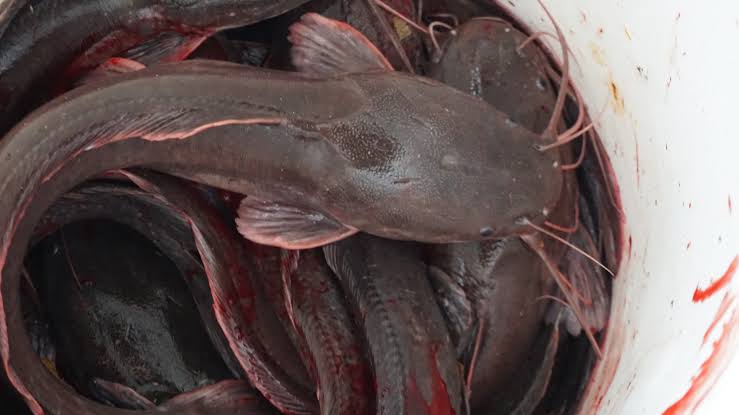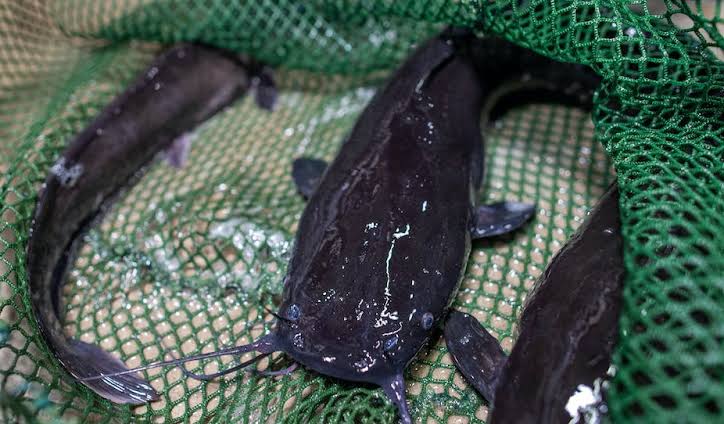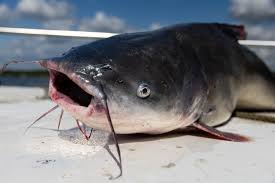Catfish are fascinating creatures that live in rivers, lakes, and ponds. These fish have a unique appearance with long whisker-like barbels that resemble a cat’s whiskers, which is how they got their name. Catfish come in various sizes and colors, ranging from small to enormous.
In the water, catfish are skilled hunters. They use their barbels to sense vibrations and locate prey, such as smaller fish, insects, and even plants. Catfish have a special skill called “whiskerflicking,” where they use their whiskers to stir up the muddy bottom of the water to find hidden food.
One interesting fact about catfish is their ability to survive in different environments. Some catfish are happy in warm, murky water, while others thrive in cooler, clearer waters. This adaptability makes catfish a diverse and widespread species, found in various parts of the world.
Catfish are known for their distinct personalities. Some species are solitary and prefer a quiet life, while others enjoy swimming in groups. They are social beings that communicate with each other through subtle movements and signals.
People have been catching catfish for centuries. Fishing for catfish can be a patient and rewarding activity. Anglers use different techniques, like using bait or lures, to attract these elusive fish. Catfish are also popular in aquaculture, where they are raised in controlled environments for food production.
Despite their popularity, catfish face challenges in the wild, including habitat loss and pollution. Conservation efforts aim to protect their natural habitats and ensure the survival of these remarkable creatures.
In addition, catfish are extraordinary fish with a distinctive appearance and behavior. Their adaptability, social nature, and role in fishing and aquaculture make them a vital part of aquatic ecosystems and human communities around the world.
Moreover, catfish play a crucial role in maintaining the balance of aquatic ecosystems. As bottom dwellers, they help control the population of smaller organisms, preventing overpopulation and maintaining a healthy environment for other aquatic species. This ecological role showcases the interconnectedness of different species in the underwater world.
Catfish are also a popular choice in the culinary world. Many people enjoy the taste of catfish, which is often described as mild and versatile. Whether grilled, fried, or cooked in various dishes, catfish can be a delicious addition to diverse cuisines.
Interestingly, the catfish family is vast and diverse, encompassing numerous species with distinct characteristics. Some catfish are known for their impressive size, while others are admired for their vibrant colors. This diversity adds to the allure of catfish for both researchers and enthusiasts.
In some cultures, catfish hold symbolic significance. They may be seen as symbols of resilience and adaptability, reflecting their ability to thrive in different environments. Stories and folklore often feature catfish as characters embodying unique qualities and lessons.
In recent times, catfish have gained popularity not only in traditional fishing and aquaculture but also in the aquarium hobby. Some catfish species are kept as pets in home aquariums, captivating enthusiasts with their interesting behaviors and striking appearances. This growing interest contributes to a better understanding of catfish and their needs in captivity.
Despite their hardy nature, catfish populations face threats from human activities, such as pollution and overfishing. Conservation efforts are crucial to ensuring the continued existence of these remarkable creatures and maintaining the health of aquatic ecosystems.
In essence, the world of catfish extends beyond their whisker-like barbels and unique appearance. They are essential contributors to aquatic ecosystems, sources of culinary delight, and even symbols in cultural narratives. Understanding and appreciating the multifaceted nature of catfish enriches our connection with the diverse and intricate tapestry of life in water.
Read Also: How to Use Mulches to Control Weeds on your Garden
Appearance and Features of Catfish

Catfish exhibit a distinctive appearance characterized by their long, whisker-like barbels, which are sensitive touch organs extending from their mouths. These barbels give them a cat-like resemblance, hence the name “catfish.” These whiskers serve a vital purpose in navigating their environment and locating food by detecting vibrations and movements in the water.
Their bodies are typically cylindrical or elongated, and they may vary in size depending on the species. Catfish skin can be smooth or covered in small, scale-like plates, and their coloration varies widely. Some catfish display muted tones that help them blend into their surroundings, while others boast vibrant hues and patterns, adding to the diversity within the catfish family.
A notable feature of catfish is their dorsal and pectoral fins, which can have sharp spines. These spines serve a dual purpose: they act as a defense mechanism against predators, and in some species, they contain venom that can cause discomfort or injury.
Catfish also possess a specialized respiratory system that allows them to breathe air. This adaptation enables them to survive in oxygen-deprived waters, where they can gulp air at the water’s surface. This ability to extract oxygen from both water and air contributes to their resilience and adaptability in various aquatic environments.
Their eyes are typically small in comparison to their body size, reflecting their preference for low-light conditions. This adaptation helps them navigate and hunt effectively, especially in habitats with limited visibility.
In addition, the appearance and features of catfish are marked by their whisker-like barbels, cylindrical bodies, variable coloration, and unique adaptations like sharp spines and the ability to breathe air. These characteristics contribute to their success in diverse aquatic habitats around the world.
Health and Lifespan of Catfish
Catfish, like many living organisms, can face health issues influenced by their environment, diet, and other factors. Common health concerns include parasitic infections, bacterial diseases, and issues related to water quality. Parasites and bacteria can affect their skin, gills, and internal organs, impacting overall well-being.
Maintaining a balanced and clean aquatic environment is crucial for preventing health issues in catfish. Adequate filtration, proper water parameters, and a suitable diet contribute to their overall health and longevity. Regular monitoring of water quality helps prevent the onset of diseases and ensures a more favorable habitat.
The lifespan of catfish varies among species, and it is influenced by factors such as genetics, habitat, and care. In the wild, catfish can live for several years, with some larger species reaching a decade or more. However, their lifespan in captivity may differ based on the conditions provided.
In aquaculture settings, where catfish are raised for food production, efforts are made to optimize their growth and well-being. Adequate nutrition and controlled environments contribute to faster growth rates, but these conditions may differ from the natural habitats where catfish would otherwise reside.
It’s essential for those keeping catfish in aquariums or aquaculture systems to be aware of their specific needs and potential health challenges. Regular veterinary check-ups, proper nutrition, and appropriate living conditions are key factors in promoting the health and longevity of catfish, whether in the wild or under human care.
Nutrition and Feeding Mode of Catfish
Catfish are opportunistic feeders with a diverse diet that varies among species. Their feeding habits are influenced by their environment, available food sources, and individual preferences. Here are some key aspects of the nutrition and feeding modes of catfish:
1. Diet Variety: Catfish are omnivorous, meaning they consume both plant and animal matter. Their diet may include small fish, insects, crustaceans, worms, and even aquatic plants. This versatility in diet contributes to their adaptability in different aquatic environments.
2. Feeding Behavior: Catfish are often bottom feeders, using their barbels to sift through the substrate in search of food. Some species exhibit nocturnal feeding behavior, becoming more active during the night to hunt and scavenge.
3. Baiting Techniques: Anglers use various baiting techniques to attract catfish. Common baits include worms, minnows, stink baits, and commercial catfish bait. Understanding the preferences of specific catfish species can enhance the success of fishing endeavors.
4. Aquaculture Feeding: In aquaculture, catfish are typically fed a formulated diet that provides essential nutrients for growth. Commercial catfish feeds often include a combination of protein sources, vitamins, and minerals. Feeding practices are carefully managed to optimize growth rates and maintain fish health.
5. Natural Behaviors: In their natural habitat, catfish exhibit behaviors such as scavenging and opportunistic feeding. They may feed on detritus and organic matter, contributing to nutrient cycling within aquatic ecosystems.
6. Cannibalism: Some catfish species, especially when young, may display cannibalistic tendencies. This behavior can be influenced by factors such as overcrowding or insufficient food supply. Proper management practices are important in aquaculture settings to minimize cannibalism.
Understanding the nutritional requirements and feeding behaviors of catfish is essential for their well-being, whether in the wild or under human care. Providing a balanced and species-appropriate diet contributes to their growth, reproduction, and overall health.
Read Also: The Appearance and Features of Snakes
How to Grow and Care for Catfish

Growing and caring for catfish, whether in an aquarium or aquaculture setting, requires attention to their specific needs. Here are some general guidelines for the growth and care of catfish:
1. Aquarium Setup: For aquarium enthusiasts, provide a tank large enough to accommodate the specific species of catfish you have. Include hiding places such as caves or driftwood, as catfish often appreciate sheltered spaces. Maintain a clean and well-filtered aquarium with appropriate water parameters. Regular water changes are essential for catfish health.
2. Water Quality: Catfish are sensitive to water quality, so it’s crucial to monitor parameters such as pH, ammonia, nitrites, and nitrates.
Use a good filtration system to keep the water clean and well-oxygenated. Ensure that the temperature of the water is within the preferred range for the species you are keeping.
3. Diet and Feeding: Provide a balanced and varied diet that includes high-quality catfish pellets, live or frozen foods, and vegetables.
Feed according to the specific dietary requirements of the catfish species. Some are predominantly herbivorous, while others are carnivorous.
4. Social Behavior: Understand the social dynamics of the catfish species you have. Some are solitary, while others prefer the company of their own kind. Avoid overcrowding, as it can lead to stress and territorial conflicts.
5. Aquaculture Practices: If involved in catfish aquaculture, ensure that the pond or tank is well-aerated and provides sufficient space for growth. Implement a feeding schedule with a nutritionally balanced diet to promote optimal growth.
6. Health Monitoring: Regularly observe your catfish for any signs of illness or abnormal behavior. If keeping multiple catfish, quarantine new additions before introducing them to the main tank to prevent the spread of diseases.
7. Handling and Tank Maintenance: Handle catfish with care, especially if they have sharp spines that can cause injury. Perform routine tank maintenance, including cleaning, water changes, and equipment checks.
8. Breeding Considerations: If interested in breeding catfish, provide appropriate conditions for spawning, including suitable nesting sites and specific water parameters.
Separate adult catfish from the fry to prevent cannibalism.
By paying attention to these aspects of growth and care, whether in a home aquarium or aquaculture facility, you can enhance the well-being and longevity of catfish under your care. Each species may have specific requirements, so it’s essential to research and cater to the needs of the particular catfish species you are keeping.
Uses of Catfish
Catfish serve various important uses, both in natural ecosystems and in human activities. Here are some notable uses of catfish:
1. Ecological Balance: Catfish contribute to the ecological balance of aquatic ecosystems by controlling the population of smaller organisms. As bottom dwellers, they help regulate the abundance of insects, crustaceans, and other fish species.
2. Aquaculture and Fisheries: Catfish are a significant source of food in many cultures. They are commonly raised in aquaculture systems for commercial purposes. Catfish farming provides a sustainable and efficient way to meet the demand for seafood.
3. Recreational Fishing: Catfish are popular targets for recreational anglers. Fishing for catfish is a common pastime, attracting enthusiasts who appreciate the challenge and excitement of catching these resilient fish.
4. Culinary Delight: Catfish are valued for their flesh, which is often described as mild and versatile. They are used in various culinary dishes, whether grilled, fried, baked, or included in soups and stews.
5. Research and Education: Catfish are subjects of scientific research, contributing to our understanding of aquatic ecosystems, fish behavior, and physiology. They are also used in educational settings to teach students about biology and ecology.
6. Aquarium Trade: Some catfish species are popular in the aquarium trade. Enthusiasts keep them in home aquariums, appreciating their unique appearances and behaviors. Catfish add diversity to aquarium ecosystems and can serve as focal points in community tanks.
7. Waste Management: In natural environments, catfish play a role in waste management by consuming detritus and organic matter. This helps maintain water quality and supports the overall health of aquatic ecosystems.
8. Symbolic Significance: Catfish hold cultural and symbolic significance in various societies. They may be featured in folklore, myths, and stories, representing qualities such as adaptability, resilience, or even spiritual meanings in some cultures.
Understanding and appreciating the multiple uses of catfish highlight their importance in both natural ecosystems and human activities. Sustainable management practices are crucial to ensure the continued availability and well-being of catfish for future generations.
Economic Benefits of Catfish

Catfish contribute significantly to various economic sectors, providing numerous economic benefits to communities and industries. Here are some key economic contributions of catfish:
1. Aquaculture Industry: Catfish farming is a major component of the aquaculture industry. Commercial catfish farming generates substantial revenue by meeting the demand for seafood in domestic and international markets. This industry creates jobs and stimulates economic growth in regions where catfish farming is prevalent.
2. Employment Opportunities: The catfish industry, including aquaculture and fisheries, creates employment opportunities at various levels. Jobs are generated in farming, processing, transportation, marketing, and retail sectors, contributing to livelihoods in rural and urban areas.
3. Export and Trade: Countries engaged in catfish farming often export their products to meet international demand. Catfish products, whether live, fresh, frozen, or processed, contribute to international trade and foreign exchange earnings.
4. Food Security: Catfish farming enhances food security by providing a reliable source of protein. The industry helps meet the dietary needs of populations globally, especially in regions where other protein sources may be limited or expensive.
5. Research and Innovation: Scientific research related to catfish farming and aquaculture contributes to innovation and technological advancements. This research may lead to improved breeding techniques, disease management strategies, and sustainable practices, benefiting the industry and associated economies.
6. Tourism and Recreation: Recreational fishing for catfish attracts anglers, both local and tourists, contributing to the tourism industry. Catfish tournaments and fishing events can stimulate local economies through tourism-related activities, including accommodations, restaurants, and retail.
7. Value-Added Products: The catfish industry extends beyond the sale of whole fish. Processed catfish products, such as fillets, smoked fish, and value-added items, create additional revenue streams. This diversification adds value to the industry and supports economic sustainability.
8. Supporting Industries: The catfish industry stimulates various supporting industries, including feed manufacturing, equipment production, and transportation. These industries provide essential inputs for catfish farming and contribute to the broader economy.
9. Environmental Services: Sustainable catfish farming practices can provide environmental services by promoting responsible water management, habitat preservation, and ecosystem conservation. These practices contribute to the long-term viability of aquatic ecosystems.
Overall, the economic benefits derived from catfish extend across multiple sectors, making it a valuable contributor to global food systems and economic development. Sustainable management practices are crucial to ensuring the continued prosperity of the catfish industry.
Read Also: 5 Early Symptoms of Tooth Decay and their Methods of Prevention
